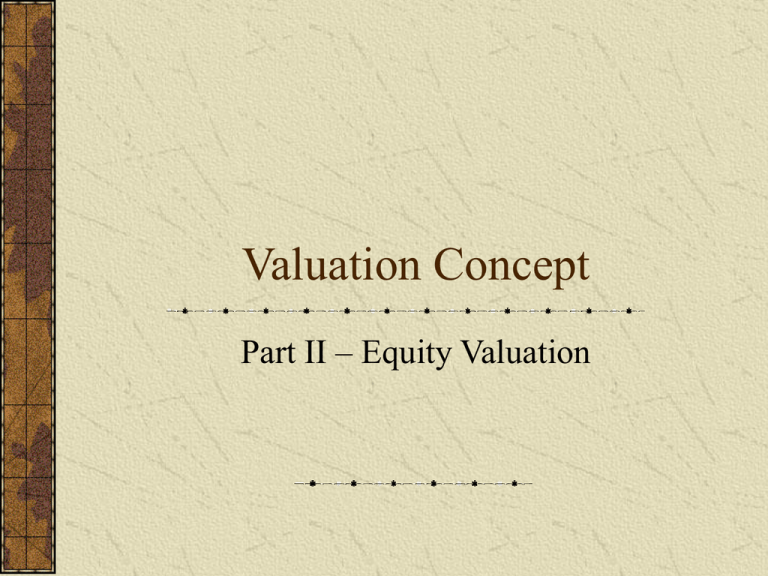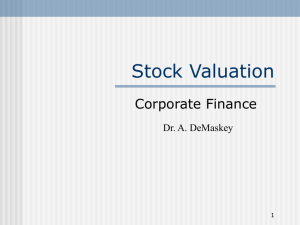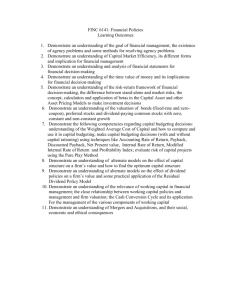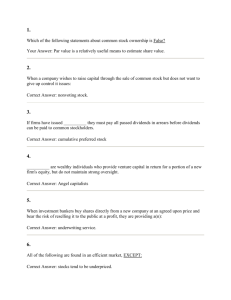Equity Valuation: Stock Valuation Models & Market Efficiency
advertisement

Valuation Concept Part II – Equity Valuation Valuation of Financial Assets – Equity (Stock) • Types of Stock: Common Stock Preferred Stock Common Stock and Bond Hybrid Definition of Terms Used in the Stock Valuation Models A stock’s value is calculated in the same manner as other financial assets; it is determined by the expected cash flows generated. For Equity issues, the expected cash flow consists of two components: Dividend stream Future Value of the stock when the investor sells it, which includes the original value (purchase price) plus and capital gains or loss. Definitions Dividends ^ Dt D0 ^ D1 Dividend expected by the investor in Year t. Most recently paid dividend. Next dividend to be paid. ^ - denotes expected value. Definitions Price ^ Pt P0 P0 ^ ^ P^ 1 Expected stock price at the end of Year t. Current market price. The theoretical (intrinsic) value of the stock as calculated by a particular investor today. The theoretical value expected at the end of year one. Definitions Rates & Yields g k^s ^ D P 1 0 ^ P1 P 0 P0 Expected dividend growth rate. When the dividend growth rate is constant, it will equal the stocks prices growth rate. Required rate of return given the riskiness and available rates. Expected dividend yield. Expected capital gains yield on the stock over the next year Definitions Rates & Yields g k^s ^ ks _ ks Expected dividend growth rate. When the dividend growth rate is constant, it will equal the stocks prices growth rate. Required rate of return given the riskiness and available rates. Expected rate of return. Actual (Realized) Rate of Return ^ ks ^ D P 1 0 ^ P1 P 0 P0 › CF1 CF2 CFn-1 CFn 1 2 n-1 n › › n › n-1 › 2 › 1 › › › › › Basic Valuation 0 Formula › Expected Dividends as the Basis for Stock Values D1 D2 Dn-1 Dn PV of CF1 PV of CF2 PV of CFn-1 PV of CFn Value › › › › Stock Valuation 0 Formula PV of D1 PV of D2 PV of Dn-1 PV of Dn Stock Value Expected Dividends as the Basis for Stock Values 1 PV FV n (1 k ) Present Value Formula Stock Value ^ ^ Vs P 0 ^ D1 1 (1 ks ) Dt t ( 1 k s ) t 1 D2 ... 2 (1 ks ) ^ D (1 ks ) The value of a firm is determined by the expected dividend payments over the life of the firm. Valuing Stocks with Zero Growth • Zero-Growth Stocks are stocks where dividends are not expected to grow (ie g=0) • Zero-Growth stock is a perpetuity. D P0 ks Valuing Stocks with Constant Growth Constant (Normal) Growth is the rate of growth which is expected to continue into the future at, or near the same rate as the economy as a whole. D 0(1 g )1 P0 1 (1 ks ) D 0(1 g ) ks g Requires that ks is greater than g D (1 g ) (1 k ) 0 2 ... s D (1 g ) (1 k ) 2 D1 ks g 0 s Constant Growth Model (or the Gordon Model) Valuing Stocks with Constant Growth Div Growth Earnings Growth Inflation Div./Reinvest. Return on Equity Expected Returns of Constant Growth Stocks Given that: P0 And that: Results in: Expected Rate of Return = ks D1 ks g Expected Dividend Yield D1 P0 + Expected growth (or Capital Gains Yield) g Nonconstant Growth Stocks Dividend Growth Rate Nonconstant Growth Normal Growth Zero Growth Declining Growth 1.6 1.4 Dividend ($) 1.2 1 0.8 0.6 0.4 0.2 0 0 1 2 3 Year 4 5 Valuing Stocks with Nonconstant Growth Nonconstant growth is that portion of a firm’s life cycle during which its growth rate is either faster or slower than the economy as a whole. Three Step Approach for Nonconstant Growth: Calculate the PV of the dividends during the nonconstant growth period. Calculate the expected price at the beginning of the constant growth period and discount to PV. Add PV from Step 1 to PV from Step 2 to calculate the intrinsic value. Examples Zero-Growth Stock What is the value of a stock which is expected to pay dividends of $0.75 per share and has a required rate of return of 15%? P0 D0 ks $0.75 $5.00 .15 Examples Zero-Growth Rate of Return What is the expected growth rate of a stock paying a $0.75 dividend and currently selling at $5.00? ks D P0 $0.75 $5.00 15% Examples Constant Growth Stock What is the value of a stock that is expected to pay dividends of $0.75 per share with an expected constant growth rate of 6% and has a required rate of return of 15%? P0 D 0(1 g ) ks g $0.75(1.06) $8.83 .15 .06 Examples Constant Growth Rate of Return What is the expected growth rate of a stock paying a $0.75 dividend that is expected to grow 6% and is currently selling for $5.00? ks D1 g P0 $0.75(1.06) .06 21.9% $5.00 Additional Formulas D1 D 0(1 g ) Capital Gains Yield g = Pnew Pold Pold Examples Nonconstant Growth Stock What is the value of a stock that is expected to pay dividends of $0.75 per share with an expected growth rate of 20% for the next 3 years and then a constant growth rate of 6%, and has a required rate of return of 15%? k Ns gs gn D0 15% 3 20% 6% $0.75 Examples Nonconstant Growth Stock STEP 1: Calculate the PV of the dividends during nonconstant growth period. Year 1 2 3 4 Ps=$2.4514 Div $0.90 $1.08 $1.30 $1.37 PV $0.78 $0.82 $0.85 Examples Nonconstant Growth Stock STEP 2: Calculate the Price of the stock at the beginning of the constant growth period. D4 P3 ks gn P3 1.37 15% 6% P3 $15.2640 Examples Nonconstant Growth Stock STEP 3: Combine PV from Step 1 and Step 2. Ps =$2.4514 P3 =$15.2640 P0 =$17.7154 = $17.72 Examples Nonconstant Growth Stock gs=6% gs=20% 0 1 2 3 4 .75 .90 1.08 1.30 1.37 .78 .82 .85 2.45 + 15.26 17.71 Stock Market Equilibrium Equilibrium, term used to describe the condition during which the expected return is equal to the required return and the price is stable. k k P0 P0 Stock Market Equilibrium Required Rate of Return (k) can be found along the Security Market Line (SML). k kRF (kM kRF ) b Where: k Required Rate of Return kRF Risk Free Rate (as estimated by LT US T-Bonds) kM Rate of Return on Market Portfolio b Beta coefficient of stock Security Market Line: Line which illustrates the relationship between risk (beta) and return rates for individual securities. Beta Coefficient:Measure which shows the correlation between the overall market and the stock being evaluated. Stock Market Equilibrium k kRF (kM kRF ) b b k kRF 0 6% kLow kM kHigh 0.5 1 2 10% 14% 22% Efficient Market Hypothesis Efficient Markets Hypothesis (EMH), hypothesis that security prices reflect all available public information, and are therefore fairly priced and in equilibrium. Levels of Market Efficiency: Weak Form Semistrong Form Strong Form Efficient Market Hypothesis Weak Form The weak form level of efficiency dictates that current market prices reflect all information in past price movements. Recent price shifts do not provide near term predictability. Efficient Market Hypothesis Semistrong Form The semistrong form level of efficiency perscribes that all publicly available information is reflected in current market prices. Efficient Market Hypothesis Strong Form The strong form level of efficiency dictates that all pertinent information (public and private) is reflected in current market prices.








